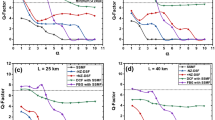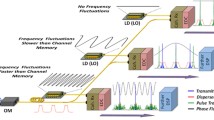Abstract
We have modeled and simulated the effect of fiber attenuation and dispersion on the maximum fiber length of 40-Gb/s optical fiber links using directly modulated high-speed laser diodes. We present the modulation characteristics of multiple-quantum-well laser diodes with a modulation bandwidth reaching 28 GHz, including the eye diagram and frequency chirp. We compare new results obtained using return-to-zero (RZ) and non-return-to-zero (NRZ) patterns of pseudorandom modulation bits. The characteristic relations for the bit error rate and received power are simulated and the receiver sensitivity of the fiber communication system is evaluated. The eye diagrams of the received signal at the fiber attenuation and dispersion-limited transmission distances are characterized. The results show that the laser chirp operates with the fiber dispersion to limit the fiber length to 2.51 and 1.37 km under the RZ and NRZ bit patterns, respectively.
Similar content being viewed by others
References
H. Dalir and F. Koyama, “Bandwidth Enhancement of Single-Mode VCSEL with Lateral Optical Feedback of Slow Light,” IEICE Electron. Exp. 8(13), 1075 (2011).
K. Petermann, Laser Diode Modulation and Noise (Kluwer Acad. Publ., Dordrecht, 1988).
K. Sato, S. Kuwahar, and Y. Miyamoto, “Chirp Characteristics of 40-Gb/s Directly Modulated Distributed-Feedback Laser Diodes,” J. Lightwave Technol. 23, 3790 (2005).
K. Yvind, D. Larsson, L.J. Christiansen, C. Angelo, L.K. Oxenlowe, J. Mork, D. Birkedal, J.M. Hvan, and J. Hanberg, “Low-Jitter and High-Power 40-GHz All-Active Mode-Locked Lasers,” IEEE Photon. Tech. Lett. 16, 975 (2004).
R.G. Hunsperger, Integrated Optics: Theory and Technology, 6th ed. (Springer, N.Y., 2009).
F.S. Ujager, S.M.H. Zaidi, and U. Younis, “A Review of Semiconductor Lasers for Optical Communications,” in Proceedings of the High Capacity Optical Networks and Enabling Technologies (HONET) (Cairo, 2010), pp. 107–111.
B. Woodward and E.B. Husson, Fiber Optics Installer and Technician Guide (SYBEX, Alameda, Calif., 2005).
ITU-T Draft Recommendation G. 693, “Optical Interfaces for Intra-Office Systems,” 2001.
C.H. Henry, “Phase Noise in Injection Lasers,” IEEE J. Lightwave Technol. 4, 298 (1986).
S. Abdulrhamnn, M. Ahmed, and M. Yamada, “A New Model of Analysis of Semiconductor Laser Dynamics under Strong Optical Feedback in Fiber Communication Systems,” Proc. SPIE. 4986, 409 (2003).
G.P. Agrawal, Fiber-Optic Communication Systems (Wiley, N.Y., 2002).
M.F. Ahmed, A.H. Bakry, and F.T. Albelady, “Digital Modulation Characteristics of High-Speed Semiconductor Laser for Use in Optical Communication Systems,” Arab. J. Sci. Eng. 39, 5745 (2014).
T.L. Koch and J.E. Bowers, “Nature of Wavelength Chirping in Directly Modulated Semiconductor Lasers,” Electron. Lett. 20, 1038 (1984).
K.Y. Lau, “Gain Switching of Semiconductor Injection Lasers,” J. Appl. Phys. Lett. 52, 257 (1988).
H. Liu, S. Oshiba, Y. Ogawa, and Y. Kawai, “Method of Generating Nearly Transform-Limited Pulses from Gain-Switched Distributedfeedback Laser Diodes and Its Application to Soliton Transmission,” J. Opt. Lett. 17, 64 (1992).
E. Peral, W.K. Marshall, and A. Yariv, “Precise Measurement of Semiconductor Laser Chirp Using Effect of Propagation in Dispersive Fiber and Application to Simulation of Transmission through Fiber Gratings,” J. Lightwave Technol. 16, 1874 (1998).
A. Villafranca, J. Lasobras, and I. Garcés, “Precise Characterization of the Frequency Chirp in Directly Modulated DFB Laser,” in Proceedings of the 6th Spanish Conference on Electron Devices (Madrid, 2007), pp. 173–176.
O. Boukari, L. Hassine, O. Latry, M. Ketata, and H. Bouchriha, “Characterization of the Chirp in Semiconductor Laser under Modulation,” Mater. Sci. Eng. 28, 671 (2008).
P. Krehlik, “Directly Modulated Lasers in Negative Dispersion Fiber Links,” Optoelectron. Rev. 15, 71 (2007).
M. Ahmed, “Modeling and Simulation of Dispersion-Limited Fiber Communication Systems Employing Directly Modulated Laser Diodes,” Indian J. Phys. 86, 1013 (2012).
S. Balle, M. Homar, and M.S. Miguel, “Statistical Properties of the Spectrum of Light Pulses in Fast Pseudorandom Word Modulation of a Single-Mode Semiconductor Laser,” IEEE J. Quantum Electron. 31, 1401 (1995).
A. Yin, L. Li, and X. Zhang, “Analysis of Modulation Format in the 40 Gbit/s Optical Communication System,” Optik-Int. J. Light Electron. Opt. 121, 1550 (2010).
D. Liu, L. Wang, and J.-J. He, “Rate Equation Analysis of High Speed Q-Modulated Semiconductor Laser,” J. Lightwave Technol. 28, 3128 (2010).
M. Ahmed, S. Mahmoud, and A. Mahmoud, “Influence of Pseudorandom Bit Format on the Direct Modulation Performance of Semiconductor Lasers,” Pramana J. Phys. 79, 1443 (2012).
M. Ahmed, S.W.Z. Mahmoud, and A.A. Mahmoud, “Comparative Study on Modulation Dynamic Characteristics of Laser Diodes Using RZ and NRZ Bit Formats,” Int. J. Num. Model. 27, 138 (2013).
M.J. Potasek and G.P. Agrawa, “Self-Amplitude Modulation of Opticl Pulses in Nonlinear Dispersive Fibers,” Phys. Rev. A. 35, 3862 (1998).
G.P. Agrawal, Nonlinear Fiber Optics (Academic Press, San Diego, 2001).
M. Ahmed and A. El-Lafi, “Analysis of Small-Signal Intensity Modulation of Semiconductor Lasers Taking Account of Gain Suppression,” Pramana J. Phys. 71, 99 (2008).
K. Sato, S. Kuwahara, Y. Miyamoto, and N. Shimizu, “40 Gbit/s Direct Modulation of Distributed Feedback Laser for Very-Short-Reach Optical Links,” Elecron. Lett. 38, 816 (2002).
N. Suzuki and T. Ozeki, “Simultaneous Compensation of Laser Chirp, Kerr Effect, and Dispersion in 10 Gb/s Long Haul Transmission Systems,” J. Lightwave Technol. 11, 1486 (1994).
S.W.Z. Mahmoud, M. Ahmed, and R. Michalzik, “Influence of Optical Feedback-Induced Phase on Turn-On Dynamics of Vertical-Cavity Surface-Emitting Lasers,” in Proceedings of the 46th IEEE Midwest Symposium on Circuits and Systems (MWSCAS’ 2003). Vol. 3, pp. 1354–1358 (2004).
M. Ahmed, M. Yamada, and S.W.Z. Mahmoud, “Analysis of Semiconductor Laser Dynamics under Gigabit Rate Modulation,” J. Appl. Phys. 101, 3119 (2007).
M. Ahmed, M. Yamada, and M. Saito, “Numerical Modeling of Intensity and Phase Noises in Semiconductor Lasers,” IEEE J. Quantum Electron. 37, 1600 (2001).
M. Ahmed, “Influence of Transmission Bit Rate on Performance of Optical Fiber Communication Systems with Direct Modulation of Laser Diodes,” J. Phys. D. 42, 185104 (2009).
I. Kim, T.J. Miller, and Y.K. Park, “10-Gb/s Transmission Using 1.3-µm Low-Chirp High-Power Directly Modulated, Packaged DFB Laser Module for Short Distance (<50 km) Applications,” IEEE Photon. Technol. Lett. 9, 1167 (1997).
I. Tomkos, B. Hallock, I. Roudas, R. Hesse, A. Boskovic, J. Nakano, and R. Vodhanel, “10-Gb/s Transmission of 1.55-µm Directly Modulated Signal over 100 km of Negative Dispersion Fiber,” IEEE Photon. Technol. Lett. 13, 735 (2001).
Author information
Authors and Affiliations
Corresponding author
About this article
Cite this article
Ahmed, M. Effect of fiber attenuation and dispersion on the transmission distance of 40-Gb/s optical fiber communication systems using high-speed lasers. Phys. Wave Phen. 22, 266–272 (2014). https://doi.org/10.3103/S1541308X14040104
Received:
Published:
Issue Date:
DOI: https://doi.org/10.3103/S1541308X14040104




